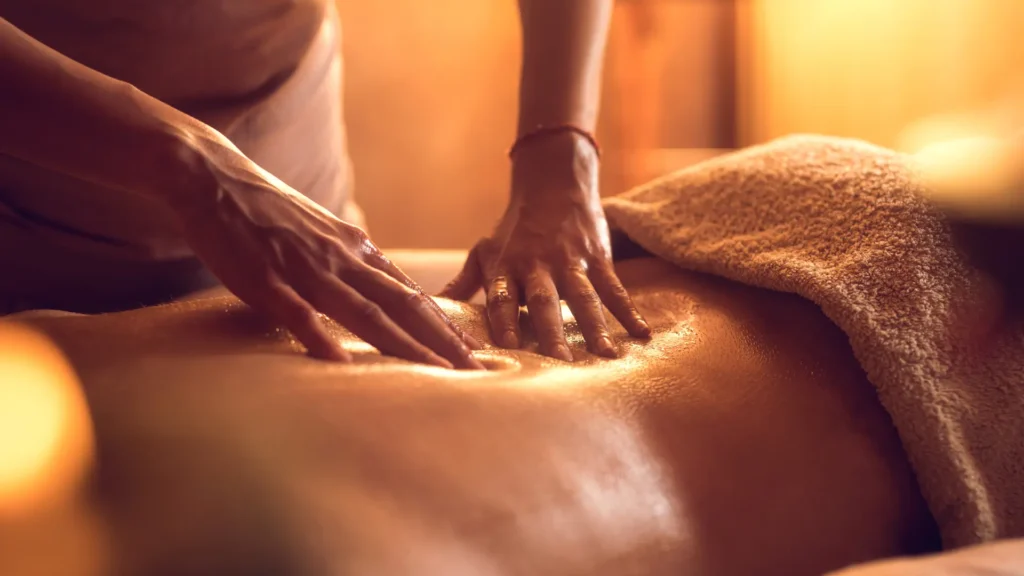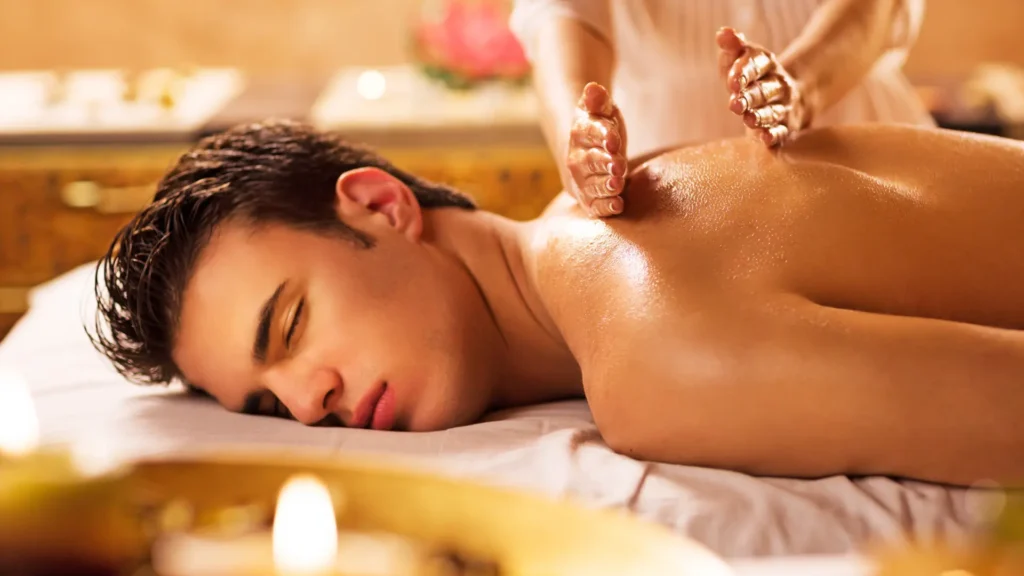What is Swedish Massage? Everything You Need to Know About
Who doesn’t crave the soothing touch of skilled hands working out the kinks from tired muscles? But when it comes to massages, not all are created equal. Enter the Swedish massage, a favorite among spa-goers and wellness enthusiasts alike. But what is Swedish massage, Actually? Is it just about relaxation, or is there more to it?
If you’ve ever pondered these questions while booking a spa appointment or scrolling through wellness blogs, you’re in the right place. In this post, we’ll dive deep into Swedish massage, uncovering its techniques, benefits, and what makes it stand out in the vast sea of massage therapies.
So, grab your comfy robe, and let’s Uncover What is Swedish Massage together!
Jump To:
Definition and Meaning of Swedish Massage
Picture this: you’re lying on a plush massage table, the soft hum of calming music in the background, and the gentle aroma of lavender wafting through the air. As the therapist’s hands glide over your body, you feel a combination of long, flowing strokes, gentle kneading, and rhythmic tapping. This is the essence of a Swedish massage.
Definition Of Swedish Massage
Swedish massage, often hailed as the “classic massage,” is one of the most well-known and widely practiced forms of therapeutic massage around the globe. But it’s not just about feeling good (though, trust me, it does!).
At its core, Swedish massage is designed to enhance the oxygen flow in the blood, detoxify the muscles, and boost overall circulation. Think of it as a tune-up for your body, targeting the uppermost layer of muscles to melt away tension and stress.
Techniques of Swedish Massage That Makes It Unique
Now, you might be wondering, “What sets Swedish massage apart from other massages I’ve heard of?”
Great question! Swedish massage is distinct in its use of five primary techniques:
- Effleurage: These long, sweeping strokes start the massage and help spread the oil and warm up the muscles.
- Petrissage: Think kneading and squeezing – like how you’d work with dough. This helps to release tension and knots.
- Friction: Deep, circular movements that help with muscle knots and can increase blood flow.
- Tapotement: A fancy term for rhythmic tapping, usually done with the edge of the hand or cupped hands.
- Vibration: Quick shaking to help relax muscles, especially in more fleshy areas.
In essence, Swedish massage is a holistic approach to relaxation and healing, ensuring both your mind and body feel rejuvenated. And while its name might sound exotic, its benefits are universal. Swedish massage offers a soothing solution, whether you’re a busy bee looking for a break or someone dealing with muscle aches.
I hope the next time you hear someone ask, “What’s a Swedish massage?” you’ll have the inside scoop!

Swedish Massage History: From Swedish Shores to Global Spas
The story of Swedish massage is as intriguing as the relaxation it offers. A blend of tradition, innovation, and a touch of luck, its journey from the heart of Sweden to spa menus worldwide is a testament to its enduring appeal.
Let’s journey back in time and trace the origins and rise of this beloved massage technique.
1. The Pioneer – Per Henrik Ling:
The roots of Swedish massage can be traced back to the early 19th century, thanks to a Swede named Per Henrik Ling. A fencing instructor by profession, Ling faced health issues, which he managed to alleviate through exercise and massage. Inspired by his personal experience and the techniques he learned from his travels, Ling developed a system known as the “Swedish Movement System.“
2. The Medical Connection:
Ling’s methods weren’t just about relaxation. He believed in the therapeutic benefits of his techniques, which combined movement and massage. His system was introduced at the Royal Central Gymnastic Institute in Stockholm, where it was used to treat various ailments and improve overall health.
3. Crossing Borders:
While Ling’s system was gaining popularity in Sweden, a Dutch practitioner, Johan Georg Mezger, played a pivotal role in introducing it to a wider audience. Mezger adopted and refined Ling’s techniques, and we use his terminology—effleurage, petrissage, tapotement—today. Thanks to Mezger’s efforts, what was known as the “Swedish Movement System” in Sweden became “Swedish Massage” abroad.
4. The Global Spa Movement:
As the 20th century dawned, the wellness and spa movement began to take shape. People worldwide were seeking holistic treatments to counteract the stresses of modern life. Swedish massage fits the bill perfectly with its promise of relaxation and therapeutic benefits. From Europe’s luxury spas to America’s burgeoning wellness centers, Swedish massage found its place on the menu.
5. Endorsements and Education:
The effectiveness of Swedish massage wasn’t just anecdotal. Over the years, numerous studies have highlighted its benefits, from improved circulation to reduced stress. This scientific backing and a growing emphasis on therapist training and certification further cemented Swedish massage’s reputation.
6. Today’s Popularity:
Fast forward to today, and Swedish massage is a global phenomenon. Its universal appeal lies in its versatility—it’s gentle enough for massage newbies yet effective enough for regular spa-goers. Whether you’re in a luxury resort in Bali, a wellness center in New York, or a local spa in a small town, Swedish massage is a staple offering, a testament to its enduring charm.
The history of Swedish massage is a tale of innovation, passion, and the timeless human desire for relaxation and well-being. From the shores of Sweden to the heart of global wellness culture, its journey is a reminder of the universal appeal of touch, care, and the magic of human connection.
What Does a Swedish Massage Involve?
Imagine entering a tranquil oasis where the world’s hustle and bustle fade into the background. As you settle into this sanctuary, you’re not just signing up for a massage but embarking on a holistic experience tailored to your well-being. But what can you expect from a Swedish massage session?
Let’s walk through it together.
1. The Prelude
Before the magic begins, your therapist will have a heart-to-heart with you. They’ll inquire about your health, lifestyle, and any specific areas of tension or discomfort. This isn’t just small talk; tailoring the massage to your unique needs is crucial. So, whether you’ve been pulling all-nighters at work or training for a marathon, be candid about it.
2. Your Personal Cocoon
Once the chat wraps up, you’ll be directed to a specially designed massage table. Here, comfort is king. You’ll be draped with soft towels, ensuring your privacy and warmth. The ambiance is often enhanced with dim lighting, calming music, and perhaps even some aromatic essential oils to transport you to a state of bliss.
3. Tools of the Trade
No, we’re not talking about the latest skincare fad. Therapists often use creams or oils for a Swedish massage to ensure their hands glide smoothly over your skin. These products not only enhance the massage experience but can also nourish your skin. Win-win!
4. The Main Event: Applying The Massage Techniques
Remember those five primary techniques we mentioned earlier? Here’s where they come into play. Your therapist will use a combination of effleurage, petrissage, friction, tapotement, and vibration, adjusting the pressure and focus based on your feedback and expertise. It’s like a symphony, with each technique playing its part to bring harmony to your body.
5. The Grand Finale: Post-Massage Care
Once your session concludes, you’ll likely feel a mix of relaxation and rejuvenation. But the care doesn’t stop there. Your therapist might offer some post-massage tips, like drinking plenty of water to flush out toxins or doing specific stretches to prolong the benefits.
In a nutshell, a Swedish massage is more than just a series of strokes and techniques. It’s a curated experience designed to cater to your physical and emotional well-being. If you still need more Clarification about its method, check out my guide on the step-by-step process of performing Swedish Massage.

Health Benefits of Swedish Massage
Let’s face it: the mere thought of a massage can make most of us eagerly sigh. That promise of an hour (or more) of pure, unadulterated relaxation is hard to resist. But did you know that a Swedish massage offers much more than a temporary escape from daily stresses?
Dive in with us as we explore the myriad health benefits of this age-old therapy.
1. The Ultimate Stress-Buster:
At the heart of it, Swedish massage is a fantastic way to combat stress. The gentle strokes and rhythmic movements help release endorphins, the body’s natural painkillers and mood elevators. So, if you’ve been feeling a tad overwhelmed lately, this massage might just be the pick-me-up you need.
2. Pain Relief and Muscle Tension:
Do you have a nagging pain in your neck or a persistent ache in your back? Swedish massage can come to your rescue. By targeting the uppermost layer of muscles, it works to alleviate muscle tension and reduce pain. It’s like giving your muscles a much-needed vacation!
3. Boosting Blood Circulation:
Those deep, circular friction movements aren’t just for relaxation. They play a pivotal role in increasing blood flow, ensuring that oxygen and nutrients reach every nook and cranny of your body. Better circulation can lead to faster recovery from injuries and overall well-being.
4. Flexibility and Joint Health:
The movement of the joints during a Swedish massage can work wonders for your flexibility. It helps reduce joint stiffness and increase range of motion, making it a boon for athletes and desk-bound professionals.
5. Aiding in Recovery and Performance:
Many athletes turn to Swedish massage as a secret weapon in their training arsenal. It helps them relax before a big event and can aid in post-event recovery, ensuring they’re always at the top of their game.
6. Therapeutic Benefits for Chronic Conditions:
Swedish massage isn’t just a luxury; it can be a lifeline for those dealing with chronic conditions. From heart disease and stomach problems to fibromyalgia and lower back pain, this massage technique has shown promising results in alleviating symptoms and improving quality of life.
7. Mental Well-being and Sleep Quality:
Lastly, let’s not forget the mind. A Swedish massage session can lead to better sleep quality, reduced anxiety, and an overall sense of mental well-being. It’s like hitting the reset button on your brain!
While the allure of a Swedish massage often lies in its relaxation promise, its benefits run deep, impacting both the body and mind. So, the next time you’re debating whether to book that massage appointment, remember: it’s not just a treat; it’s a treatment.

Pros and Cons of Swedish Massage
No matter how beneficial, every therapy comes with its advantages and considerations. Swedish massage, despite its widespread popularity, is no exception.
Let’s delve into the pros and cons to help you decide whether it’s the right choice for you.
Pros of Swedish Massage:
- Mind and Body: Swedish massage offers a holistic approach to relaxation, targeting both the physical body and the mind, ensuring you leave the session feeling rejuvenated.
- Natural Relief: For those wary of pain medications, Swedish massage offers a natural alternative to manage and alleviate pain, especially related to muscle tension and chronic conditions.
- Holistic Health: The techniques used in Swedish massage promote better blood flow, ensuring oxygen and nutrients are efficiently delivered throughout the body.
- Move with Ease: Regular sessions can improve flexibility and range of motion, making daily activities and exercises more comfortable.
- Mood Elevator: The release of endorphins during the massage can act as a mood booster, helping combat feelings of anxiety and depression.
- Restful Nights: Many individuals report better sleep patterns after a Swedish massage, attributing it to the deep relaxation experienced during the session.
Cons of Swedish Massage:
- Not Suitable for Everyone: Individuals with certain medical conditions, such as deep vein thrombosis or recent fractures, should avoid Swedish massage or consult with a physician beforehand.
- Temporary Discomfort: Some people might experience slight soreness after the session, especially if it’s their first time or if deep pressure was applied.
- Budget Consideration: Regular massage sessions can be a financial commitment; not all insurance plans cover therapeutic massage.
- Time Commitment: Setting aside time for a massage, especially in hectic routines, can be challenging for some individuals.
- Allergic Reactions: Some people might have allergic reactions to the oils or creams used during the massage. It’s always a good idea to inform the therapist of any known allergies beforehand.
In short, while Swedish massage offers many benefits, weighing these against the potential considerations is essential. As with any therapy or treatment, individual experiences may vary, so it’s always a good idea to listen to your body and consult with professionals when in doubt.
Final Words On What is Swedish Massage
With its rich history and holistic approach, Swedish massage has cemented its place as a favorite in therapeutic massages. Its myriad benefits, from physical relaxation to mental well-being, make it a sought-after choice for many. However, as with any therapy, it’s essential to approach it with an informed perspective, understanding its advantages and considerations. Whether you’re considering it for relaxation, pain management, or a mental health boost, Swedish massage promises a journey of rejuvenation and healing.
Key Takeaways:
- Holistic Relaxation: Swedish massage offers comprehensive relaxation, targeting both the body and mind.
- Natural Pain Management: It provides a natural alternative to pain medications, especially for muscle-related tensions.
- Enhanced Blood Circulation: The massage techniques promote better blood flow, ensuring efficient delivery of oxygen and nutrients.
- Mental Health Benefits: Regular sessions can help combat feelings of anxiety and depression, thanks to the release of endorphins.
- Considerations: While beneficial, Swedish massage might not be suitable for everyone, especially those with specific medical conditions. It’s essential to consult with a physician if in doubt.
FAQs:
How long does a typical Swedish massage session last?
A standard session can range from 30 minutes to 90 minutes, depending on the client’s preference and the therapist’s recommendation.
Is Swedish massage the same as deep tissue massage?
While both involve similar techniques, deep tissue massage focuses on the deeper layers of muscle and connective tissue, whereas Swedish massage targets the uppermost layer of muscles.
Can I get a Swedish massage if I’m pregnant?
Many therapists offer prenatal Swedish massages tailored for expectant mothers. However, consulting with your healthcare provider before booking a session is crucial. For Further Clarification, Read out my Guide on: Can You get a Swedish massage if Pregnant?
How often should I get a Swedish massage?
The frequency varies based on individual needs. Some people benefit from weekly sessions, while others might opt for a massage once a month. It’s best to discuss with your therapist for a personalized recommendation.
Will I be sore after a Swedish massage?
Some individuals might experience slight soreness, especially after their first session or if deep pressure was applied. However, this usually subsides within a day or two.
With this comprehensive guide on Swedish massage, I hope you’re better equipped to make an informed decision about this therapeutic journey. Remember, listening to your body and choosing what feels right for you is key.






